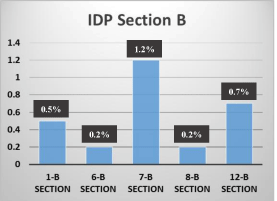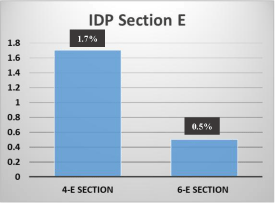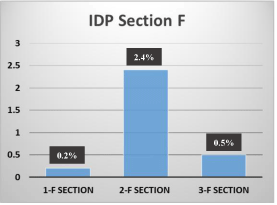Abstract
Background: The inappropriate drugs prescription is defined as the risk of suffering adverse effects compared to the clinical benefit, especially when there is evidence of the existence of safer and more effective therapeutic alternatives.
Aim: The purpose of this study is to determine the frequency of inappropriate drugs prescription in patients =65 years with chronic diseases in Tijuana, Mexico.
Design and Setting: Descriptive cross-sectional study.
Methods: In 410 patients in the Family Medicine Unit #27, Tijuana, Mexico; a descriptive cross-sectional study was conducted in older adults with chronic diseases from June to December 2018. We obtained general data such as age, sex, marital status, schooling, occupation, weight, height, body mass index, polypharmacy, chronic diseases and inappropriate drugs prescription. For statistical analysis, we applied descriptive statistics; for qualitative variables frequencies and percentages were used and for quantitative variables mean and standard deviation were used.
Results: An inappropriate drugs prescription of 38.3% was found with a higher percentage in section A-1 with 18% and Section 1-K with 7.8%; paracetamol and clonazepam were the drugs with the highest inappropriate prescription.
Conclusion: The STOPP criteria have proven to be a good tool for the detection of potentially inappropriate prescriptions and can improve the quality of prescription in medical care. Like any tool, it does not replace clinical judgment but serves as a guide for the rational prescription of medications, it is also necessary to consider the life expectancy, the time until the benefit of the drug, the care goals and the patient's preferences.
Keywords: STOPP criteria; Chronic diseases; Inappropriate drug prescription
Introduction
The Official Mexican Standard NOM-031-SSA3-2012 considers “old adult” as a person of 60 or more years of age [1]. However, geriatricians often think that the elderly are divided into three categories, the old-young man from 65 to 74 years old, the old-old man from 75 to 84 years old and the frail elderly from 85 and older. Older adults have three or more chronic illnesses and ingest 4-9 drugs that include medicines, herbal products and food supplements; these conditions show us that we must pay close attention to the type of pharmacological therapies that we prescribe for the elderly [2]. Aging influences pharmacokinetic and pharmacodynamics changes in different ways, there are drugs that should be avoided or their dosage should be adapted, some medications should not be modified and others should be modified. Physiological changes such as decreased hepatic mass, blood flow and the activity of certain enzymes that metabolize drugs are slowed down, reducing doses is necessary. The reduction of creatinine clearance below 50 ml/min in older adults is sufficient to require the reduction of the dose of some medications. [3].
Inappropriate prescribing is defined as the risk of suffering adverse effects superior to clinical benefit, especially when there is evidence of the existence of safer and more effective therapeutic alternatives. The inappropriate prescription includes the use of drugs with a greater frequency or greater duration, the use of drugs with a high risk of drug interactions and duplicated drugs of the same class [4]. Polypharmacy is a criterion of frailty in the elderly and a risk factor for morbidity and mortality due to the risk of drug interactions, adverse effects (risk of falls, cognitive deterioration and sensory alterations), decreased therapeutic adherence and greater use of healthcare resources (increase in hospitalizations). A distinction must be made between appropriate and inappropriate polypharmacy, that is, the consumption of many drugs but all of them with a clinical indication and the consumption of more drugs than are clinically necessary; the factors related to inappropriate polypharmacy include biological, psychological and social factors, but also of the prescribing physician and the health system [5].
Polypharmacy is defined as the use of at least one potentially inappropriate drug or the presence of 5 or more medications at the same time [6]; the amount of different medications a person takes is the single most important predictor of inadequate prescription [7]. In 2014, the STOPP/START [Screening Tool of Older Persons Potentially Inappropriate Prescriptions (STOPP)] and [Screening Tool to Alert Doctors to Right Treatment (START)] criteria were updated, with the participation of 19 experts in geriatrics and geriatric Polypharmacy is defined as the use of at least one potentially inappropriate drug or the presence of 5 or more medications at the same time [6]; the amount of different medications a person takes is the single most important predictor of inadequate prescription [7]. In 2014, the STOPP/START [Screening Tool of Older Persons Potentially Inappropriate Prescriptions (STOPP)] and [Screening Tool to Alert Doctors to Right Treatment (START)] criteria were updated, with the participation of 19 experts in geriatrics and geriatric
Materials and Methods
A descriptive cross-sectional study was carried out, in the Family Medicine Unite #27, of the Instituto Mexicano del Seguro Social (IMSS), located in Tijuana, Mexico; in patients which were selected by a consecutive sampling techniques; that met the following inclusion criteria: age =65 years, with any chronic disease and with at least two medical consultations in the last six years, it was not necessary to sign the informed consent due to the fact that only clinical records were reviewed; patients with incomplete information were eliminated. The following data were obtained directly from medical records: age, sex, marital status, schooling, occupation, weight, height, body mass index, polypharmacy, chronic diseases and inappropriate drugs prescription.
The procedure for the data collection was as follows: age was calculated in years according to the year of birth; sex was determined by the phenotype characteristics of each individual; marital status was expressed by each patien; occupation and schooling was determined by asking directly to patients; polypharmacy was evaluated according to the number of medications that the patient has prescribed; comorbidities was evaluated according to the presence of chronic diseases; weight and height was calculated on a scale with stadiometer (Transcell technology model TI-540-SL); BMI was calculated based on the Quetelet index (BMI = weight/height2); inappropriate drugs prescription was evaluated with the STOPP test version 2 modified in 2014, that consists of 81 items which divide them into section A: indication of medication, section B: cardiovascular system, section C: Antiplatelet-anticoagulants, section D: Central nervous system and psychotropic, section E: system renal, section F: gastrointestinal system, section G: respiratory system, section H: musculoskeletal system, section I: urogenital system, section J: endocrine system, Section K: drugs that adversely affect falls in elderly people, section L: analgesics, section N: antimuscarinic and anticholinergic drugs; the result will be positive to inadequate prescription when finding a single medication badly prescribed according to the STOPPv2 instrument.
The recollected data was integrated into data collection sheets and analyzed using the SPSS program version 20 in Spanish, where we applied descriptive statistics; for qualitative variables, frequencies and percentages were used and for quantitative variables, mean and standard deviation were used. The Kolmogorov-Smirnoff test was used to establish the normality of the data. The Protocol was authorized by the Local Committee of Research and Ethics in Health Research.
Results
We reviewed the electronic medical record of 410 patients in the period between June to December 2018; of all patients, 159 (38.8%) were men and 251 (61.2%) men. The age was distributed in a range of 65-94 years, the average was 72.5 ± 7.2 (SD) years, the age group with the highest frequency was 65-75 years with a percentage of 69.3% (n = 284); the weight among the participants had an average of 73.6 ± 14.2 (SD) kg and the height had an average of 1.57 ± 0.097 (SD) meters. Marital status was distributed as follows: single 7.1% (n=29), married 69.3% (n=284), free union 3.2% (n=13), divorced 1.0% (n=4), widower 19.5% (n=80). The schooling found was as follows: primary 48.5% (n=199), secondary 34.1% (n=140), technical 5.3% (n=23), high school 6.8% (n=28), bachelor's degree 4.9% (n=20).
In occupation it was found that the majority of participants were pensioners with 44.4% (n=182), followed by housewife 42.7% (n=175), retired 7.6% (n=31) and employee with 4.1% (n=17). In the body mass index (BMI), the following percentages were founded: low weight with 1.5% (n=6), normal weight 21.5% (n=88), overweight 33.4% (n=137), obesity grade 1 29.5% (n=121), obesity grade II 9.8% (n=40), obesity grade III 4.4% (n=18). The majority of participants had polypharmacy with 79.3% (n=352). The distribution of chronic diseases was as follows: diabetes mellitus with 49.5% (n=203), arterial hypertension 82.2% (n=337), osteoporosis 5.1% (n=21), dyslipidemia 12.9% (n=53), hypothyroidism 5.9 % (n=24), heart disease 9.3% (n=38), neurological diseases 5.1% (n=21), respiratory diseases 7.6% (n=31), chronic kidney disease 7.8% (n=32) and other diseases 39.8% (n=163), in this group, the most frequent were: benign prostatic hypertrophy 7.3% (n=30), glaucoma 5.1% (n=21) and peripheral venous insufficiency 3.9% (n=16).
A prevalence of 38.3% (n=157) in the inappropriate drugs prescription was found among the participants (graphic 1); in chronic diseases the following distribution of inappropriate prescription of drugs (IDP) was found: diabetes mellitus 41.9% (n=85), hypertension 38.9% (n=131), osteoporosis 42.9% (n=9), dyslipidemia 50.9% (n=27), hypothyroidism 41.7% (n=10), cardiac diseases 55.3% (n=21), neurological diseases 38.1% (n=8), respiratory diseases 45.2% (n=14), chronic kidney disease 40.6% (n=13), other diseases 35.6% (n=58). The inadequate prescription by sections was as follows (graphic 2): section A (indication of medication); indication 1-A: any medication without an indication based on clinical evidence with 18.0% (n=74); indication 2-A: any prescribed medication with a duration greater than that indicated when the duration of treatment is well defined 1.2% (n=5); 3-A indication: any concomitant prescription of two drugs of the same class 2.7% (n=11). In section A, the three most frequent IDP were paracetamol 2.7% (n=11), indomethacin 2.7% (n=11), sulindac 1.7% (n=7).

Figure 1: Descriptive analysis of the distribution by IDP.

Figure 2: Descriptive analysis of the distribution by IDP in section A.
The IDP in section B (Cardiovascular System) was the following (graphic 3): section 1-B: digoxin for heart failure with normal vascular systolic function (0.5%, n=2), there is no clear evidence of its benefit; section 6-B: loop diuretics as a first-line treatment for hypertension (0.2%, n=1), there are safer and more effective alternatives; section 7-B: loop diuretics for malleolar edema (1.2%, n=5) without clinical, biochemical or radiological evidence of heart failure, liver failure, nephrotic syndrome or renal failure; section 8-B: thiazide diuretics when there is significant hypokalemia, hyponatremia or hypercalcemia or with a history of gout (0.2%, n=1); section 12-B: aldosterone antagonist together with other drugs that can increase potassium without monitoring potassium (0.7% n=3). In this section, the drugs with the highest PID were furosemide 1.2% (n=5), spironolactone 0.7% (n=3) and digoxin 0.5% (n=2).

Figure 3: Descriptive analysis of the distribution by IDP in section B.
The PID in section D (central nervous system and psychotropic) was as follows (graphic 4): section 2-D: start with tricyclic antidepressant as first-line antidepressant treatment with 2.7% (n=11); section 5-D: benzodiazepines for more than 4 weeks (2.7%, n=11), there is no indication for longer treatment. In this section, the drugs with the highest PID were clonazepam 5.4% (n=22), imipramine 2.7% (n=11) and diazepam 1.2% (n=5). The PID in section E (Renal System) was as follows (graphic 5): section 4-E: NSAID with glomerular filtration rate (eGFR) <50ml/min/1.73m2 (1.7%, n=7); section 6-E: metformin with eGFR <30ml/min/1.73m2 (0.5%, n=2). In this section, the drugs with more IDP were sulindac 0.5% (n=2), paracetamol 0.5% (n=2) and metformin 0.5% (n=2).

Figure 4: Descriptive analysis of the distribution by IDP in section D.

Figure 5: Descriptive analysis of the distribution by IDP in section E.
The PID in section F (Digestive System) was as follows (graphic 6): section 1-F: metoclopramide with parkinsonism (0.2%, n=1), risk of worsening of symptoms; section 2-F: proton pump inhibitors for uncomplicated peptic ulcer disease or erosive peptic esophagitis for more than 8 weeks (2.4% n=10); section 3F: medications that cause constipation in patients with chronic constipation when there are better alternatives (0.5%, n=2). In this section, the drugs with the highest PID were omeprazole 2.7% (n=11), aluminum and magnesium 0.5% (n=2).

Figure 6: Descriptive analysis of the distribution by IDP in section F.
The IDP in section G (Respiratory System) was as follows: section 4-G: non-cardioselective beta-blockers oral or topical for glaucoma in patients with a history of asthma requiring treatment (1.0%, n=4). In this section the drug with the highest IDP was propranolol 0.5% (n=2). The PID in section H (Musculoskeletal System) was as follows (graphic 7): section 2H: NSAID with severe arterial hypertension or severe cardiac failure 0.5% (n=2); section 3-H: long-term NSAID greater than 3 months for treatment of osteoarthritis when paracetamol has not been tested 1.0% (n=4), section H-8: NSAID with corticosteroid without prophylactic proton pump inhibitor 0.2% (n=1). In this section, the drugs with the highest IDP were indomethacin 1.5% (n=6) and piroxicam 0.2% (n=1).

Figure 7: Descriptive analysis of the distribution by IDP in section H.

Figure 8: Descriptive analysis of the distribution by IDP in section J.
The IDP in section J (Endocrine System) was as follows (graphic 8): section 1-J: long-acting sulfonylureas with type 2 diabetes (4.4%, n=18); section 3-J: beta-blockers in diabetes mellitus with frequent episodes of hypoglycaemia 0.5% (n=2). In this section, the drugs with the highest PID were glibenclamide 4.4% (n=18) and metoprolol 0.5% (n=2). The IDP in section K (drugs that increase the risk of falls) was the following (graphic 9): section 1-K: sedative benzodiazepines (7.8%, n=32), can reduce the level of consciousness and alter the balance; section 3-K: vasodilators with persistent postural hypotension 0.2% (n=1). In this section, the drugs with the highest PID were clonazepam 6.6% (n=27) and diazepam 1.2% (n=5).

Figure 9: Descriptive analysis of the distribution by IDP in section K.
Discussion and Conclusion
The inappropriate prescription was found in 38.3% when applying the STOPP tool, the sections where the highest percentage was found were section K (drugs that predictably increase the risk of falls) with 7.8%; section A1 with a percentage of 18%, with the most inappropriately prescribed medications being NSAIDs and benzodiazepines, among them paracetamol and clonazepam. The STOPP criteria have proven to be a good tool for the detection of potentially inappropriate prescriptions and can improve the quality of prescription in medical care. Like any tool, it does not replace clinical judgment but serves as a guide for the rational prescription of medications, it is also necessary to take into account the life expectancy, the time until the benefit of the drug, the care goals and the patient's preferences.
References
- Norma Oficial Mexicana NOM-031-SSA3-2012. Asistencia social y prestación de servicios de asistencia social a adultos y adultos mayores en situación de riesgo y vulnerabilidad. Mexico: secretaria de salud.
- Mukhtar O, Jackson SH. Drug therapies in older adults (part1). Clincal Medicine. 2015; 15: 47-53.
- Burris J, Tortorici M, Mandic M, Neely M, Reed M. Dosage Adjustments Related to Young or Old Age and Organ Impairment. The Journal of Clinical Pharmacology. 2016; 56: 1461–1473.
- Prescripción Farmacológica Razonada para el Adulto Mayor. Guia de practica clínica, México: Secretaría de Salud; 2010.
- Filomena-Paci J, García-Alfaro M, Redondo-Alonso FJ, Fernandez-San- Martin MI. Prescripción inadecuada en pacientes mayores de 64 años en atención primaria. Aten Primaria. 2015; 47: 38-47.
- Manejo de los síndromes geriátricos asociados a complicaciones postoperatorias. Guia de práctica clínica, México: Instituto Mexicano del Seguro Social; 2013.
- Yong TY, Khow KSF. Prescribing appropriately in frail older people. Healthy Aging Research. 2015; 4: 1-12.
- Gallo C, Vilosio J. Actualización de los criterios STOPP-START, una herramienta para la detección de medicación potencialmente inadecuada en ancianos. Evid Act Pract Ambul. 2015; 18: 124-129.
